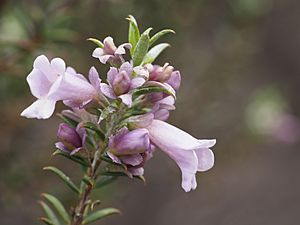Eremophila psilocalyx facts for kids
Quick facts for kids Eremophila psilocalyx |
|
|---|---|
 |
|
| Eremophila psilocalyx leaves and flowers | |
| Scientific classification | |
| Genus: |
Eremophila (plant)
|
| Species: |
psilocalyx
|
| Synonyms | |
|
|
Eremophila psilocalyx is a beautiful flowering plant found only in Western Australia. It belongs to the figwort family, which is called Scrophulariaceae. This plant is a shrub that stands upright, often looking like a broom. It has thin, hooked leaves and flowers that can be white, pink, blue, or purple. You can often find it growing in the mallee areas around Esperance.
Contents
What Does Eremophila psilocalyx Look Like?
Eremophila psilocalyx is a shrub that grows straight up. It can reach a height of about 0.8 to 3 meters (2.6 to 9.8 feet). It has many branches that start right from the ground.
Branches and Leaves
The branches of this plant are smooth and have small, raised bumps. They also have tiny glands that make a sticky resin (like sap), especially near the ends of the branches.
The leaves grow one after another along the branches. They are narrow and shaped like a spear, getting thinner at the bottom. The very end of each leaf has a small hook. Most leaves are about 11 to 26 millimeters (0.4 to 1 inch) long and 2 to 4 millimeters (0.08 to 0.16 inches) wide. They are smooth and can be sticky when they are young.
Flowers and Fruits
The flowers grow either alone or in pairs where the leaves meet the stem. Each flower sits on a smooth, sticky stalk that is about 3 to 5 millimeters (0.12 to 0.2 inches) long.
There are 5 sepals (leaf-like parts that protect the flower bud) that overlap. These sepals are cream-colored to purple and are about 6 to 11 millimeters (0.24 to 0.43 inches) long. They are mostly smooth.
The petals are joined together at their base, forming a tube. This tube is about 10 to 20 millimeters (0.4 to 0.8 inches) long. The petal tube can be white, lilac, pink, blue, or purple on the outside. Inside, it's white with yellow-brown spots. The petals and the tube are smooth, except for the inside of the bottom petal and the inside of the tube, which have soft, long hairs.
The plant has 4 stamens (the parts that make pollen), and these are completely hidden inside the petal tube.

When Does It Flower?
Eremophila psilocalyx usually flowers from July to October, and sometimes even into December. After the flowers, the plant produces dry, oval-shaped fruits that are about 3 to 4 millimeters (0.12 to 0.16 inches) long.
How Was Eremophila psilocalyx Named?
The scientific name for this plant, Eremophila psilocalyx, was first officially described by a scientist named Ferdinand von Mueller in 1876. He published his description in a book called Fragmenta phytographiae Australiae.
Meaning of the Name
The second part of the name, psilocalyx, comes from two ancient Greek words:
- psīlós means "smooth" or "bare."
- kálux means "cup" or "cover."
This name refers to the sepals of the flower, which are smooth.
Another scientist, Ludwig Diels, later named the same plant Eremophila pachyphylla. It seems he didn't know that Ferdinand von Mueller had already described and named it earlier.
Where Does Eremophila psilocalyx Grow?
Eremophila psilocalyx is a very common plant found across a wide area in Western Australia. You can see it between Lake King and Balladonia.
It grows in different types of areas, including:
- Flat plains
- Saltpans (areas where salt collects)
- Rocky hillsides
It can grow in many different kinds of soil.
Is Eremophila psilocalyx Protected?
The Western Australian Government's Department of Parks and Wildlife has classified this species as "not threatened." This means it is not currently in danger of disappearing.
Growing Eremophila psilocalyx in Gardens
This plant is not grown in gardens very often, but it could be! It has many beautiful flowers, a neat shape, and its colorful sepals stay on the plant for a long time after the flowers are gone. These features make it a good choice for gardens.
How to Grow It
You can try to grow new plants from cuttings (small pieces of the plant). However, it can be very slow to grow roots this way, sometimes taking up to a year!
A much easier way to grow it is by grafting. This is when you join a piece of Eremophila psilocalyx onto the rootstock (the root system) of another plant, like a Myoporum. The two parts then grow together as one plant.
Once grafted, it can grow well in most soils. It likes a sunny spot or a place with some shade. This plant is also very good at handling dry conditions (drought tolerant) and can survive some frost.

